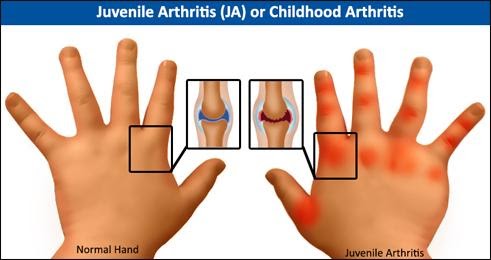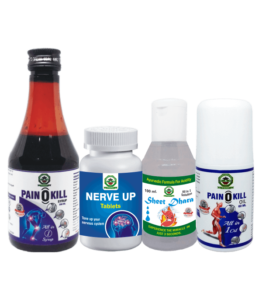
AYURVEDIC MANAGEMENT OF JUVENILE ARTHRITIS
- April 27, 2021
- Posted by Dr. Vaidya Karanvir Singh
- 0 Comment(s)
JUVENILE REUMATOID ARTHRITIS (JRA) is a type of arthritis which is also known as Juvenile idiopathic arthritis, is a common condition in children below 17 years of age. Juvenile rheumatoid arthritis leads to bone stiffness, swelling and stubborn joint pain. The symptoms vary patient to patient, some patients have the signs and symptoms for a few months while others may have them throughout their lives.
Juvenile rheumatoid arthritis can cause serious complications, such as growth problems and eye inflammation. JRA is more common in girls as compared to boys.
Table of Contents
THE COMPLICATIONS WHICH ARE MOST SUFFERED ARE
EYE PROBLEMS
- The patient suffering from juvenile arthritis can get uveitis.
- If it is left untreated, it can result in cataracts, glaucoma and even blindness.
- In JRA eye inflammation frequently occurs without symptoms, so it’s important for children with juvenile RA to be examined regularly by an ophthalmologist.
GROWTH PROBLEMS
- Juvenile rheumatoid arthritis can affect the child’s growth and bone development.
- Some medications used to treat juvenile rheumatoid arthritis, mainly corticosteroids, can inhibit growth too.
SIGNS AND SYMPTOMS
- Persistent joint pain, morning stiffness, swelling, usually in smaller joints of hands and feet.
- Redness or inflammation in one or more joints of the body.
- Warm, Swollen and tender joints are affected in a symmetrical pattern or joints of both side of body is affected.
- Fever with fleeting rashes
- Swollen lymph nodes, especially the neck lymph nodes.
- Preference for one arm or leg over the other, due to inflammation or pain.
- Limping walk, often due to knee stiffness after waking up
- Excessive clumsiness
- Generalized fatigue and feeling of unwell.
- Sleep disturbances.
- Fever and headache.
- Restricted movement in the affected joints.
- In advanced stages there are deformities in the joints.
- RA nodules or firm lumps under the skin of pressure points such as knuckles, fingers, hands and elbows.
CAUSES
Though, the exact causes of juvenile arthritis are still unknown. However, JRA is considered to be an autoimmune disorder in which the immune system attacks its own cells and tissues. And reasons which trigger it can be
- Genetic mutations that cause the immune system to act abnormally and attack its own cells.
- Could be an environmental trigger, such as a virus or a bacterial infection.
In Ayurveda, there are three energies or Humors – vata, kapha and pitta are responsible for the health of an individual. AGGRAVATED VATA AND KAPHA DOSHAS ARE RESPONSIBLE FOR JOINT PROBLEMS. But in Amavata, alonwith vata aggravation, accumulation of ama (toxin) in the body causes the joints pain and inflammation.
There are various factors like lifestyle and improper eating habits which causes vata aggravation and ama formation.
ASSOCIATED FACTORS THAT MAY WORSEN THE CONDITION
- GENETIC PREDISPOSITION – The chances of getting JRA if one of your family members has a history of juvenile arthritis are more..
- At all ages, females are more likely to develop rheumatoid arthritis than males.
- Psychologically, stress can worsen the symptoms. As it increases vata dosha.
- Sex hormones may play a role in causing or modulating arthritis.
DIAGNOSE
- ERYTHROCYTE SEDIMENTATION RATE (ESR) – Helps to diagnose JRA and determines the degree of inflammation.
- C-REACTIVE PROTIEN – This blood test is also used to measure the levels of general inflammation in the body but on a different scale than the ESR.
- ANTI NUCLEAR ANTIBODY – Anti-nuclear antibodies are proteins commonly produced by the immune system of patients with certain autoimmune diseases, including arthritis.
- RHEUMATOID FACTOR – It checks the presence of antibody in the blood of children with rheumatoid arthritis.
- CYCLIC CITRULLINATED PEPTIDE (CCP) – Just like the rheumatoid factor, the CCP is another antibody that may be found in the blood of children with JRA.
- EVALUATION OF FAMILY HISTORY – Check how many of patient’s family members are suffering with JRA. Also keep track of the family history of other autoimmune diseases as they also increase the risk of developing JRA.
TYPES OF JRA
- POLYARTICULAR – Children suffering from this experience inflammation in more than 5 joints. These children might also have liver swelling, spleen, or lymph nodes.
- JUVENILE PSORIATIC ARTHRITIS – In this arthritis there is occurrence of another disease called psoriasis that affects the skin.
- ENTHESITIS – In this type there is feeling of tenderness where bone and connective tissues meet and there is joint inflammation too. The hips, knees, and feet are affected commonly.
- SYSTEMIC JRA – It is the least common type. It has the symptoms of Rash and spiking fever.
- OLIGOARTICULAR JRA – This is the most common form of JRA. In this the patient experiences inflammation in five or fewer joints, usually in the wrists or knees.
JUVENILE RHEUMATOID ARTHRITIS & AYURVEDA
According to Ayurveda, aggravated or imbalanced vata, kapha dosha and accumulation of Ama, are responsible for joint pains.
TREATMENT APPROACH
General approach or any treatment procedure or formulation will be pacifying Vata and Amapachana.
For increasing the Agni, excretion of Aama and removal of vitiated and accumulated Doshas, Shodhana and Shamana treatments are given.
SHODHANA OR PURIFICATION THERAPY
This category of treatment comes under Panchkarma therapy. It consists of
- SNEHANA – Generally snehana or oleation is done with medicated ghee processed with milk and bitter medicines.
- LEPA – Paste made of suitable medicines are applied over areas where pain, discoloration, edema or burning is felt. When paste gets dried itself, it will be removed.
- ABHYANGAM – Mild massage with suitable oils may be done in appropriate conditions.
- PARISHEK – Pouring of herbal decoctions, medicated milk is very useful especially when patient is suffering from burning sensation or throbbing pain.
- VASTI – Medicated or retention enemas. Medicated enema with medicated oils/ghee and Ksheeravasthi (containing medicated milk) are useful.
- VAMANA – Medicated emesis.
- VIRECHANAM – Medicated purgation
- NASYAM – Giving medicines in the form of nasal drops. It can be oil or any herb extract which pacifies vata.
- RAKTAMOKSHANA – Bloodletting
Out of these treatments the medicated enema is considered to be the most effective and specific option for this category of diseases.
Medicated or retention enemas include herbal decoction enemas and oil enemas.
Herbal retention enemas remove Aama and accumulated Doshas. Various herbs that are used are
- Dashmoola
- Rasna
- Eranda (Ricinis communis)
- Bala (Sida cordifolia)
- Shatavari (Asparagus racemosus)
- Guduchi (Tinospora cordifolia)
- Ashwagandha (Withania somnifera)
- Gokshura (Tribulus terrestris).
Oil retention enemas help to replenish the depleted body constituents. Various oils used are
- Panchkola Ghrita
- Rasnadi Ghrita
- Ashwagandha Ghrita
- castor oil
- Dhanvantara Tailam
- Narayana Tailam.
Based upon the clinical condition of the patient these can be advised less frequently or even every other day.
SHAMANAM OR PACIFYING THERAPY
“Shamana treatments” are recommended when the patient is not able to tolerate the Shodhana treatments. These are also given as maintenance treatments after the purifying treatments, to pacify the remaining doshas. These treatments help eliminate accumulated Doshas and Aama out of the body and to regain strength. Various Ayurvedic herbal preparations used in the management of Aamavata are mentioned below:
DECOCTIONS
- Maha Rasnadikwatha,
- Ashwagandharistha
- Bhallatakasava – Pitta prakruti people should not be given this, as it can cause adverse reactions in them.
- Rasna Panchak Kwatha
- Dashamoolarishta and Amritarishta.
POWDERS
Ajmodadi Churna, Panchakol Churna, Dashamool Churna, Rasna Churna,Musta Churna, Shunthi Churna, Ashwagandha Churna, Vaishwanara Churna, Kariramoola.
TABLETS
Simhanad Guggulu, Mahayogaraja Guggulu, Triphala Guggulu, Yogaraja Guggulu, Punarnava Guggulu.
GHEE/OILS
Panchakola Ghrita, Rasnadi Ghrita, Dashamula Taila, Eranda Taila (castor oil), Narayana Taila, Ashwagandha Ghrita, Dhanvantara Taila.
AVALEHA
Bhallataka Avaleha, Gorakha Avaleha.
PATHYA AHARA/RECOMMENDED FOOD
- Warm water infused with Panchkola (Pippali, Pippalimula, Chavya, Chitraka, Shunthi) in small quantity at a time helps in digestion and digestion of Aama.
- Barley, horse gram, kodo millet and the red variety of rice should be consumed. These food items are light and easy to digest. Barley kernels and products made from barley lower the inflammatory markers.
- Green leafy vegetables and fruits contain a variety of polyphenols, catechins, carotenoids, bioflavonoids, vitamin C, riboflavin, vitamin E, and low molecular weight compounds. These constituents have antioxidant, fibrinolytic and anti-inflammatory properties. Vegetables, specially with bitter taste like bitter melon (Memordica charantia), Neem (Azadirachta indica), Patola or luffa, Gokharu (Tribulus terrestris) should be consumed.
- Spices like ginger, turmeric and garlic help to add flavor to these dishes and also have antimicrobial, analgesic and anti-inflammatory properties besides their Agni enhancing property.
- Asava and Arishta.
- Meat of Laav Pakshi – Jungle bush quail (Perdicula asiatica) prepared with traditional buttermilk is suggested in RA.
APATHYA AHARA OR FOODS YOU SHOULD AVOID
The majority of allergens come from dairy and animal products, which cause an increased production of pro-inflammatory prostaglandins.
- Cold and impure water
- Lentils like Urad and heavy foods(heavy to digest).
- Vegetable like arabi or eddo (Colocacia antiquorum) Indian spinach (Basella rubra).
- Fish and sea foods.
- Keeping all the symptoms and disease condition in mind Chandigarh Ayurved And Panchkarma Centre has manufactured ‘Juvenile Arthritis Care Kit” which cures the disease from its root cause and chances of reoccurrence are almost nill.
- It contains : Pain o kill syrup, Pain o kill oil, Nerve up Tablets and Sheet dhara
Juvenile Arthritis Care Kit

Dr. Vaidya Karanvir Singh is the younger Vaidya in Chandigarh Ayurved & Panchakarma Centre. He is the fourth generation in his family who is practicing as a general consultant in Ayurved & Panchakarma treatment at Chandigarh. In his practice, he had treated more than 1 Lakh Plus patients worldwide.


